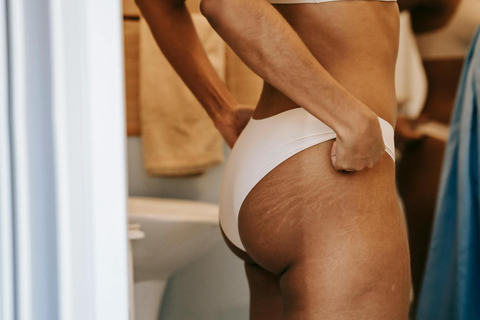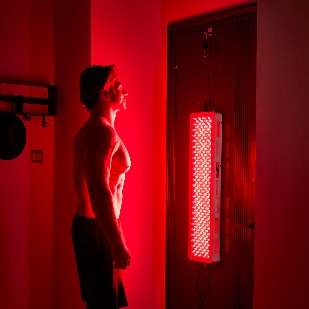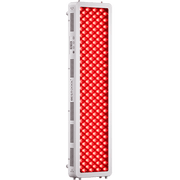Understanding Stretch Marks
Stretch marks occur when the middle layer of the skin (dermis) is continuously stretched and torn, causing the deeper layers of the skin to emerge and streaks to form. Stretch marks can be triggered by several reasons, such as physical factors contributing to increased skin tone (such as exercise), changes in the skin's internal structure or function, and hormonal influences.
Stretch marks can be seen in many scenarios, such as pregnancy, weight gain or extreme weight loss, growing too fast during puberty, hormone therapy, and more. In dermatology, psoriasis patients treated with topical corticosteroids for a long time have common stretch marks on the skin.

The occurrence of stretch marks is not limited to women. The incidence is 11% in normal men and up to 88% in pregnant women. Studies have reported that women with a family history of stretch marks are more likely to develop stretch marks, and higher pre-pregnancy body mass index (BMI), rapid weight gain during pregnancy, older gestational age, and multiple pregnancies are all risk factors for stretch marks.
Stretch marks can appear in various body areas, such as the abdomen, thighs, hips, and breasts. Although medically speaking, stretch marks are not harmful, they act as a source of anxiety for women and men by affecting their quality of life.
Stretch Marks Treatment
In general, it is difficult to treat stretch marks in medicine. The goal of treatment is to reduce the difference in color or texture between the streaks and adjacent normal skin. No treatment can completely eliminate stretch marks. Additionally, tretinoin treatment is harmful to use during pregnancy and lactation due to its known teratogenic effects. Some clinical studies have shown that interventions such as red light therapy, pulsed dye lasers, and fractional lasers may be beneficial for fading stretch marks. Red light therapy applications are very popular nowadays due to their non-invasive and safe treatment properties.
How Red Light Therapy Fade Stretch Marks?
The principle of red light therapy is that near-infrared and red potent wavelengths (630–850 nm ) penetrate the top layer of the skin and stimulate fibroblasts to repair and regenerate collagen.
Red light can act on the mitochondria of human cells, and the red light is strongly absorbed by the mitochondria of the cells, producing an enzymatic reaction, promoting cell metabolism, enhancing the synthesis of elastic fibers and collagen fibers, and rearranging the broken fiber web, thereby repairing stretch marks.
NASA has demonstrated that red light helps improve skin tissue. NASA (National Aeronautics and Space Administration) used red light technology to care for skin damage in astronauts. Later, it was proven that red light promotes collagen regeneration and blood circulation and stimulates cell activity in the skin. It can also achieve wrinkle removal, lifting and firming, repairing damaged skin, removing stretch marks, and other effects.
Why is red light therapy suitable for fading stretch marks?
Red light therapy offers a unique treatment for the skin and overall body healing. In general, the advantages of red light therapy in the treatment of stretch marks are the following:

- Light therapy is gentle and non-damaging and allows the body to naturally convert light energy into cellular energy, which is a non-invasive and gentle treatment method that can protect the tissues around the skin from injury and damage.
- Red light LED can be absorbed by targeted areas, penetrating deep into the skin's bottom. This targeted approach helps to address the root causes of stretch marks, such as damaged collagen and elastin fibers. The treatment is more advanced, and the effect is fast.The therapy dosage can be adjusted, which can effectively adjust the appropriate irradiation according to the stretch mark status, fissure area, and depth.
- Promotes elastic fiber and collagen regeneration.Red light can stimulate cells, especially fibroblasts, and rearrange the broken fiber network. Red light can improve the cell activity of the dermis level by acting on collagen and increasing elastic fiber and collagen regeneration. It also works by increasing blood flow, reducing inflammation, and effectively enhancing healing.
Red Light Therapy Usage for Stretch Marks
- Choose the right red light therapy device, which is specifically designed for skin rejuvenation purposes and is made of 640–850 nm wavelengths. Large optical power density: ≥ 40 mW/cm2 effectively treats stretch marks.
- Before applying the red light on body parts, thoroughly clean and dry the area to remove any residual dirt and cosmetics.
- Follow instructions carefully about treatment duration and distance from the device. For beginners, it is recommended not to exceed a session of 30 minutes.
- Consistent use of red light therapy, following the recommended exposure times and frequency, is key to achieving optimal results.
- Monitor progress and keep track of any sort of changes. Consult a dermatologist for personalized treatment protocol. Red light therapy can also be used in combination with topical creams and traditional remedies such as vitamin E oil, etc
Timeline for Seeing Results from Red Light Therapy for Stretch Marks
Red light treatment is medically effective in repairing stretch marks. Most people report noticeable improvements in the appearance of their stretch marks within 4–12 weeks of consistent use. Factors such as the severity of the stretch marks, skin type, and individual response to the therapy can influence the timeline. Patience and a consistent routine are key to achieving the best possible results.
Conclusion
In short, red light therapy is a simple, non-ablative method and has significant efficacy in treating stretch marks. It not only fades stretch marks and reaches the dermal skin more steadily and accurately, but it also stimulates the production of collagen and meets the need to repair stretch marks. In layman's terms, it allows the skin to heal naturally by triggering therapeutic After therapy, stretch marks will not rebound, and the effect can be maintained for a long time. Because of the wearable characteristics of red light therapy, it can be used at home with ease for fading stretch marks.













 Small
Small

 Moderate
Moderate

 Moderate
Moderate

 Moderate
Moderate

 Full
Full



